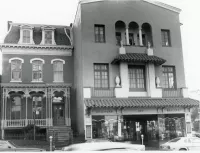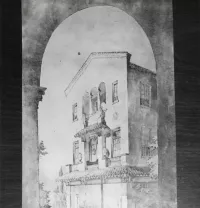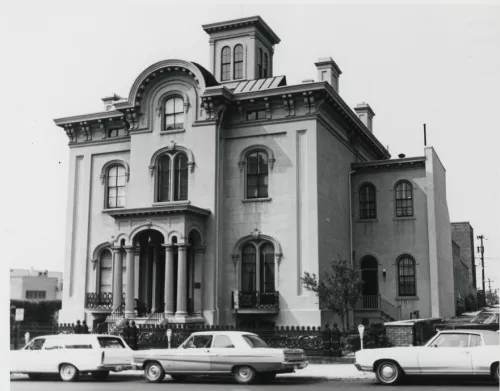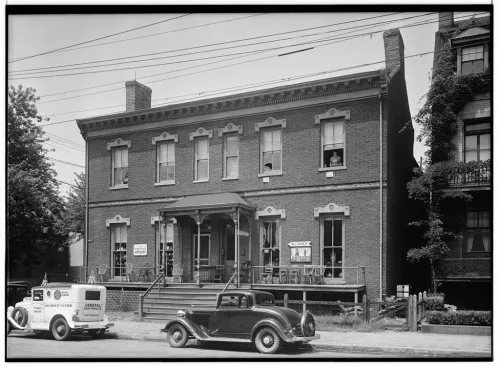Share what you know,
and discover more.
Share what you know,
and discover more.
Jun 11, 1979
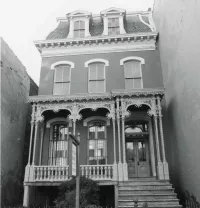
-

- Charmaine Bantugan
National Register of Historic Places - Joseph P. Winston House
Statement of Significant: The Joseph P. Winston House is significant to Richmond's architectural history as one of the few remaining 19th-century residential structures on now highly commercial Grace Street. Built by a successful Richmond merchant, the house now stands as an isolated example of 19th-century building practices and styles during the South's Reconstruction Period. Built at a time when American domestic architectural elements were becoming popularized in builder's catalogues, the house incorporates "stock" materials that were available in catalogues that would have served the Richmond area. The house's exterior details, such as cornice and ironworks, along with interior elements, such as doors and moldings, may be found in such catalogues. Although mass-produced, the quality of these materials appears to be in keeping with the standards of craftsmanship found during the antebellum period, and in keeping with the relatively high social status of the original builder, Joseph P. Winston. Not only is the house significant as an artifact of the city's architectural history but also as a document of the city's changing residential trends. When erected by Joseph P. Winston in 1873-4 on land purchased from the estate of Richard C. Wortham in 1872, the neighborhood was occupied by affluent professionals and merchants. Joseph Winston, probably from Hanover County, came to Richmond around 1850 and conducted a successful wholesale grocery and commission business in the city until his death in 1880. Winston's choice of an address on East Grace Street was most likely influenced by its location near his business, as well as the homes of his associates. The Winston family occupied the house until 1895, when Winston's widow moved to Jefferson County, Kentucky, ultimately selling the property in 1903 to Albert Fletcher. The house then had an accession of owners until its acquisition in 1929 by the Joel family, the founders of the Richmond Art Company next door and present owners of both properties. Both structures serve as a statement of changing trends in Richmond's commercial development - the Winston House as the home of a Richmond merchant, built in a residential neighbor- hood gone commercial, and the Richmond Art Company, designed by the Richmond architect Duncan Lee, a commercial structure that stands in a neighborhood that continues to undergo redefinition.
National Register of Historic Places - Joseph P. Winston House
Statement of Significant: The Joseph P. Winston House is significant to Richmond's architectural history as one of the few remaining 19th-century residential structures on now highly commercial Grace Street. Built by a successful Richmond merchant, the house now stands as an isolated example of 19th-century building practices and styles during the South's Reconstruction Period. Built at a time when American domestic architectural elements were becoming popularized in builder's catalogues, the house incorporates "stock" materials that were available in catalogues that would have served the Richmond area. The house's exterior details, such as cornice and ironworks, along with interior elements, such as doors and moldings, may be found in such catalogues. Although mass-produced, the quality of these materials appears to be in keeping with the standards of craftsmanship found during the antebellum period, and in keeping with the relatively high social status of the original builder, Joseph P. Winston. Not only is the house significant as an artifact of the city's architectural history but also as a document of the city's changing residential trends. When erected by Joseph P. Winston in 1873-4 on land purchased from the estate of Richard C. Wortham in 1872, the neighborhood was occupied by affluent professionals and merchants. Joseph Winston, probably from Hanover County, came to Richmond around 1850 and conducted a successful wholesale grocery and commission business in the city until his death in 1880. Winston's choice of an address on East Grace Street was most likely influenced by its location near his business, as well as the homes of his associates. The Winston family occupied the house until 1895, when Winston's widow moved to Jefferson County, Kentucky, ultimately selling the property in 1903 to Albert Fletcher. The house then had an accession of owners until its acquisition in 1929 by the Joel family, the founders of the Richmond Art Company next door and present owners of both properties. Both structures serve as a statement of changing trends in Richmond's commercial development - the Winston House as the home of a Richmond merchant, built in a residential neighbor- hood gone commercial, and the Richmond Art Company, designed by the Richmond architect Duncan Lee, a commercial structure that stands in a neighborhood that continues to undergo redefinition.
Jun 11, 1979
National Register of Historic Places - Joseph P. Winston House
Statement of Significant:The Joseph P. Winston House is significant to Richmond's architectural history as one of the few remaining 19th-century residential structures on now highly commercial Grace Street. Built by a successful Richmond merchant, the house now stands as an isolated example of 19th-century building practices and styles during the South's Reconstruction Period.
Built at a time when American domestic architectural elements were becoming popularized in builder's catalogues, the house incorporates "stock" materials that were available in catalogues that would have served the Richmond area. The house's exterior details, such as cornice and ironworks, along with interior elements, such as doors and moldings, may be found in such catalogues. Although mass-produced, the quality of these materials appears to be in keeping with the standards of craftsmanship found during the antebellum period, and in keeping with the relatively high social status of the original builder, Joseph P. Winston.
Not only is the house significant as an artifact of the city's architectural history but also as a document of the city's changing residential trends. When erected by Joseph P. Winston in 1873-4 on land purchased from the estate of Richard C. Wortham in 1872, the neighborhood was occupied by affluent professionals and merchants. Joseph Winston, probably from Hanover County, came to Richmond around 1850 and conducted a successful wholesale grocery and commission business in the city until his death in 1880. Winston's choice of an address on East Grace Street was most likely influenced by its location near his business, as well as the homes of his associates. The Winston family occupied the house until 1895, when Winston's widow moved to Jefferson County, Kentucky, ultimately selling the property in 1903 to Albert Fletcher. The house then had an accession of owners until its acquisition in 1929 by the Joel family, the founders of the Richmond Art Company next door and present owners of both properties. Both structures serve as a statement of changing trends in Richmond's commercial development - the Winston House as the home of a Richmond merchant, built in a residential neighbor- hood gone commercial, and the Richmond Art Company, designed by the Richmond architect Duncan Lee, a commercial structure that stands in a neighborhood that continues to undergo redefinition.
Posted Date
Jul 14, 2023
Historical Record Date
Jun 11, 1979
Source Name
National Register of Historic Places
Source Website
Delete Story
Are you sure you want to delete this story?


